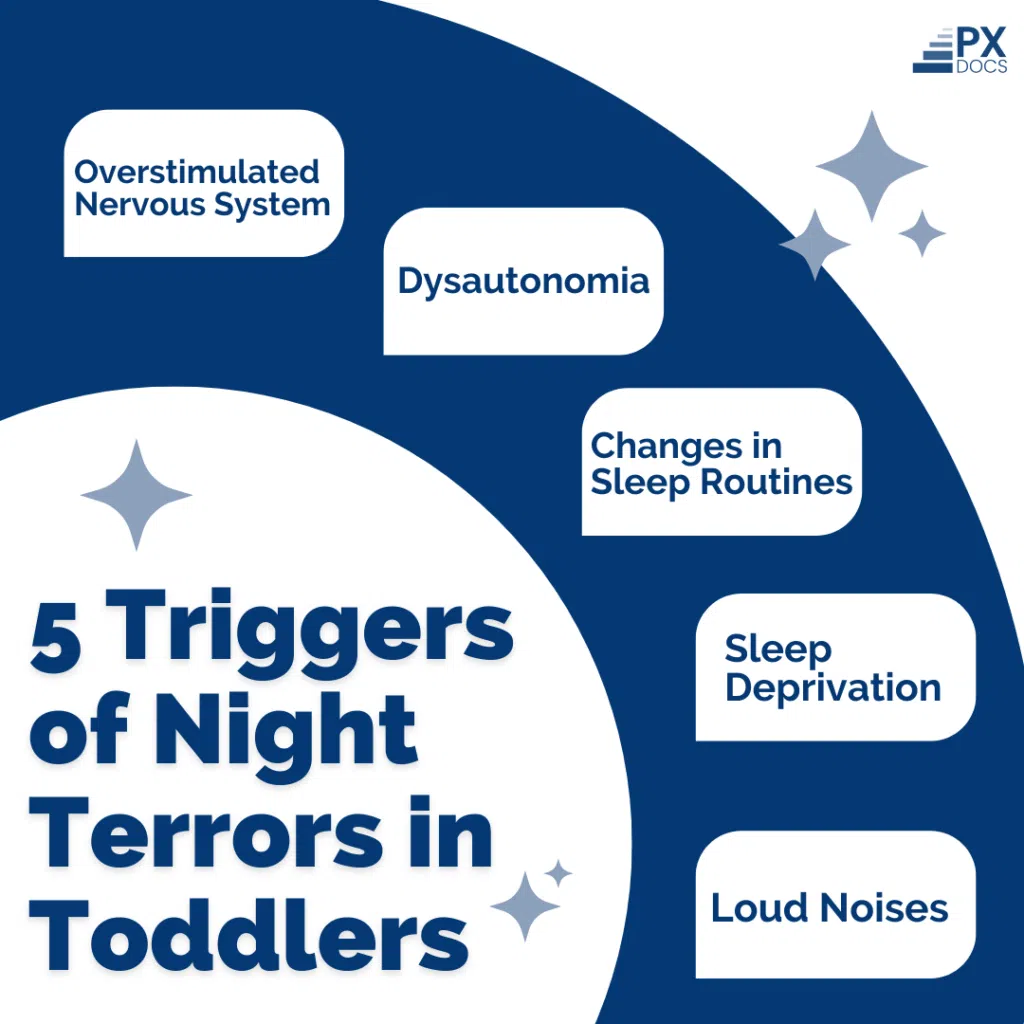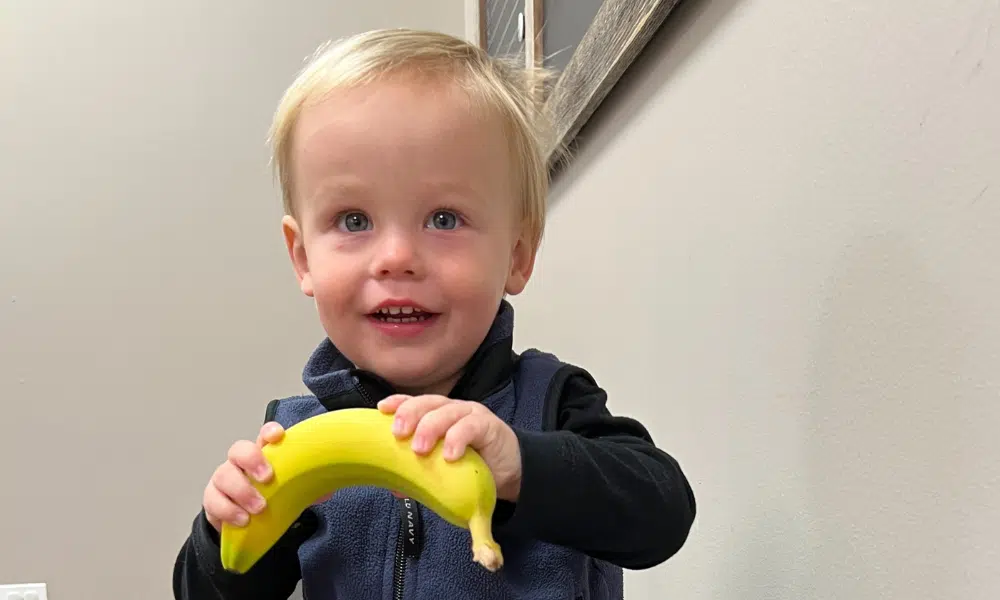Night terrors, also known as sleep terrors, are intense episodes of fear or dread that occur during deep non-REM sleep in children, typically between the ages of 2 and 6. Unlike nightmares, children experiencing night terrors may appear extremely frightened, often screaming, thrashing, or showing signs of panic without fully waking up or being responsive to comfort.
These episodes usually last a few minutes but can be distressing for both the child and parents. While most pediatricians and medical professionals continue to tell parents that night terrors in toddlers are harmless and their child will “grow out of them” over time, we see again and again in our clinic that kids who experienced a high degree of night terrors and sleep challenges early in life begin to struggle with things such as Sensory Processing Disorder, ADHD, and Anxiety later on in life.
Understanding Night Terrors in Toddlers
This article will not only explain what night terrors in toddlers are and what’s causing them, but we’ll also explore the possible link and correlation between this particular challenge and other neurosensory conditions and sleep disorders later in life.
Differentiating Night Terrors from Nightmares
Night terrors have distinct characteristics that set them apart from nightmares. While nightmares are vivid dreams that occur during REM sleep and are often remembered upon waking, night terrors happen during non-REM sleep and are usually not remembered by the child. Night terrors in toddlers can also be more intense, with the child exhibiting extreme fear and physical manifestations such as sweating or rapid breathing. In contrast, nightmares can be disturbing but are generally less intense and can be recalled by the child.
Age Range and Frequency
Night terrors in toddlers typically occur between the ages of 2 and 6. During this developmental stage, children experience changes in their sleep patterns and brain development, which can contribute to night terrors. The frequency of night terrors varies among individuals, but they tend to decrease as the child grows older. As you’ll see later on in the article, they often change forms later on and turn into difficulty sleeping and other sleep disorders in kids, teens, and even adults.
Causes and Triggers

Various factors, including external triggers and environmental influences, can trigger night terrors in toddlers. Loud noises, sudden awakenings, or disruptions to the sleep routine can contribute to night terrors. Additionally, sleep deprivation and irregular sleep schedules can increase the likelihood of night terrors in toddlers.
Perhaps the most overlooked cause and trigger of night terrors in toddlers is an overstimulated and overactive sympathetic “fight or flight” nervous system.
As a child begins to fall asleep and get to sleep, this side of the autonomic nervous system is supposed to wind down and shut down. In contrast, the parasympathetic “rest and digest” side of the nervous system kicks in and takes over to initiate and create healthy sleep patterns.
Many children struggling with conditions such as Sensory Processing Disorder, Autism, and ADHD have underlying conditions known as Dysautonomia and Subluxation, which lead to this ongoing neurological imbalance and dysfunction that could be contributing to the higher frequency and severity of night terrors.
Recognizing Night Terrors
Behavioral Indicators
During night terrors, toddlers may exhibit distinctive behaviors, such as screaming, thrashing, or appearing agitated. They may seem inconsolable and unresponsive to comfort from parents or caregivers. Recognizing these behaviors can help differentiate night terrors from other sleep disturbances.
Sleep Patterns and Phases
Understanding the sleep cycle in toddlers is essential to comprehend how night terrors occur. Toddlers go through various stages of sleep, including non-REM and REM sleep. Night terrors in toddlers typically happen during non-REM sleep, particularly during deep sleep phases.
Differentiating Night Terrors from Other Sleep Disorders
It is important to distinguish night terrors in toddlers from other parasomnias or sleep disorders in children. Conditions such as sleepwalking or confusional arousals can resemble night terrors, but they have distinct features and require different management approaches.
Impact and Consequences
Emotional and Psychological Effects
Night terrors can cause short-term distress and confusion for the toddler experiencing them. They may feel scared or anxious even after the episode has ended. Additionally, night terrors can have an emotional toll on parents and caregivers, who may feel helpless or worried about their child’s well-being.
Sleep Disruption and Daytime Consequences
Night terrors in toddlers can disrupt sleep patterns, leading to insufficient rest for both the child and parents. This can result in fatigue, irritability, and difficulty concentrating during the day. Toddlers experiencing frequent night terrors may exhibit changes in behavior and mood, impacting their overall well-being.
Potential Long-term Implications
While the average pediatrician or medical doctor will still most commonly tell parents that night terrors in toddlers are generally harmless and tend to resolve on their own, they have been associated with an increased risk of other sleep disorders later in childhood. And clinically, in our practice, we see them show up again and again in the early childhood section of the case history for kids struggling with Autism, ADHD, Sensory Processing Disorder, and other neurological conditions later on in life.
Understanding and caring for the root cause of night terrors during the formative toddler years may help mitigate potential long-term consequences. Anytime we can address the root cause and neurophysiology of a health challenge early on in a child’s life, we not only improve their quality of life during that season but also help ensure optimal health and neurodevelopment later on.
Coping Strategies for Parents
Creating a Soothing Sleep Environment
Establishing a calm and comforting bedroom atmosphere can help reduce the occurrence and intensity of night terrors in toddlers. Ensuring the bedroom is dark, quiet, and free from potential disturbances can create a more conducive sleep environment for toddlers.
Implementing a Consistent Bedtime Routine
Having a consistent bedtime routine can signal to the toddler that it is time to sleep and help promote a more regular sleep schedule. This routine may include activities such as reading a book, taking a warm bath, or engaging in calming activities to prepare the child for sleep.
For additional help and more natural sleep remedies for kids, please see this article.
Techniques During a Night Terror Episode
When a night terror episode occurs, parents should remain calm and avoid trying to wake the child, as it may prolong the episode. Instead, providing a safe environment and offering reassurance once the episode has ended can help comfort the child without exacerbating the situation.
Addressing Underlying Triggers and Factors
Identifying potential triggers and eliminating them from the child’s sleep environment can reduce the frequency of night terrors in toddlers. Naturally, this involves minimizing exposure to loud noises, establishing a consistent sleep schedule, and promoting healthy sleep habits and routines.
Additionally, consulting with a trained and ready PX Doctor to find out if your child’s nervous system is overstressed, subluxated, and stuck in sympathetic fight or flight mode is often the crucial missing step for families whose child continues to struggle with night terrors and other sleep challenges despite doing all they can to optimize sleep habits and routines.
Tips for Siblings and Other Family Members
Supporting Siblings
Helping siblings understand and cope with night terrors is important to maintain a harmonious family environment. Educating siblings about night terrors, promoting empathy, and providing reassurance can help alleviate their concerns and fears.
Educating Extended Family Members and Caregivers
Sharing information and guidelines about night terrors with grandparents, babysitters, and other caregivers is crucial to ensure consistent strategies are implemented across all individuals involved in the child’s care. This can help create a supportive network and promote a unified approach to managing night terrors in toddlers.
Chiropractic Care for Night Terrors
Like any and all conditions, chiropractic care does not seek to treat or cure night terrors in toddlers but instead looks to address their root cause – neurological imbalance and dysfunction.
Improvements in sleep are the first and most common benefit parents report to us when their children are under Neurologically-Focused Chiropractic Care. This is because the very first goal we have with our care is to activate the parasympathetic nervous system and vagus nerve, getting the “rest + digest” system back online. Which in turn also finally begins to slow down and lessen the sustained sympathetic fight or flight mode children struggling with night terrors are most commonly stuck in.
If you’re tired of seeing your child struggling night after night with night terrors and difficulty sleeping, reach out and connect with your local PX Doctor right away to schedule an in-depth consultation and examination, which includes the Neurological INSiGHT Scans. These scans will help find out if subluxation and dysautonomia could be the root cause of your child’s challenges all along, and then your PX Doctor will sit down and go through a customized Care Plan made specifically for your child.





